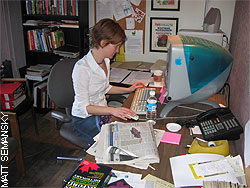This Magazine Is About Chaos
New editor Jessica Johnston brings passion to the job, but she may offer something even more important to the current affairs publication on its 40th anniversary—stability.
As we sit down to lunch at Tequila Bookworm, a funky, laptop-friendly coffee shop on Queen Street West, Jessica Johnston and I both notice a familiar problem. Our table is wobbling on its uneven base. While I whine about our poor luck, Johnston chooses to address the issue head-on. She grabs a handful of napkins and places them under the table, establishing a stable plane for our conversation. “It’s one of my superpowers,” she says, and though she’s speaking specifically about her knack for fixing wobbly tables, she might as well be talking about a general ability to create order from chaos.
Johnston will get a chance to demonstrate such talents at This Magazine, the current affairs and culture publication that recently named her its latest editor. The magazine has been a fixture in Canada since 1966, when it began its life as This Magazine Is About Schools. It has served as an incubator for such literary and journalistic talents as Margaret Atwood, Naomi Klein and Clive Thompson. Given that so many hall-of-famers have appeared on its pages and in its offices, one might expect This Magazine to be one of the most organized publications in the country, but it has always thrived in an unpredictable environment, maintaining a steady circulation of almost 5,000 subscribers with limited resources at its disposal. As former editor Patricia D’Souza says, “It’s a seat-of-the-pants organization.” And Johnston, who turned thirty just three days after taking over the editor’s chair on April 3, is about to find out if she can fly.
I have first-hand experience with the hectic, often improvisational culture of This Magazine, having served a two-month internship there in the summer of 2005. In a small office shared with two other interns, publisher Lisa Whittington-Hill, editor Emily Schultz and art director Stephen Gregory, I performed tasks such as fact-checking and copy editing. But I also spent almost an entire day wandering the streets of Toronto with Schultz, looking for a bakery that could design a cake for the cover of an issue celebrating Alberta’s centennial.
The field trip is an example of the daily surprises that come with a job at This Magazine. According to Whittington-Hill, those unexpected jolts are a blessing. “It makes you want to tear your hair out sometimes but it’s exciting. You never know what’s going to happen.” When I ask her what she’s learned since becoming This Magazine‘s publisher in January 2005, Whittington-Hill considers the question for several seconds before a grin spreads over her face. “That I’m never going to quit smoking,” she laughs. “And that I handle pressure better than I thought I would.”
There’s a particular kind of pressure Whittington-Hill is familiar with – dealing with staff turnover. She has witnessed the departure of D’Souza, who became associate editor of Canadian Geographic in July 2005 after just over a year at This Magazine, and Schultz, who called an abrupt halt to her seven-month tenure in February 2006. Whittington-Hill understands why editors leave – the position only pays $30,000 per year and demands long hours – but she would like to slow down the revolving door that has been spinning so furiously during the last couple of years. “It’s hard for the magazine when there’s too much turnover,” she says. “It’s hard for the readers, too, when a new editor comes in with a different take every few months.”
Johnston is introducing her take on things in the midst of This Magazine‘s fortieth anniversary, but unlike her two most recent predecessors, she plans to stay on long after the celebrations are over. Her dedication to the magazine is evident in the fact that she accepted a significant pay cut from her copy editing gig at theNational Post to take what she calls her “dream job.” Such sacrifice is important at a magazine that can’t afford to motivate employees or freelancers with money. The editorial budget for an average issue is $2,000 and contributors generally earn in the neighbourhood of ten cents per word – a sliver of what larger publications like Toronto Life offer. “We wish we could pay our writers more,” says Whittington-Hill, “but in a way it makes us lucky because people don’t write for us for the money. They do it because they like the magazine.
Johnston’s affection for her new employer verges on puppy love – she claims to have “had a crush” on This Magazine for several years, having discovered it at Simon Fraser University in British Columbia, where she was news editor for the student paper. When she moved to Toronto in 2003 and began working as a communications co-ordinator at the independent record label owned by folk musician Loreena McKennitt, her office was right beside This Magazine‘s. Taking advantage of the serendipity, she began to form a relationship with the magazine. “It took some courage to knock on the door,” she says, “but after that, I started stalking them – and they encouraged that.” Her stalking took the form of freelance contributions, copy editing and eventually a position as co-editor of This & That, the magazine’s front-of-book section. She occupied that role, along with Shawn Micallef, from July 2005 until being hired as editor-in-chief.
Johnston expects her current commitment to last roughly three years. “It’ll take time to get the magazine to the point where it reflects my vision,” she says. That vision includes getting This Magazine the respect she feels a forty-year-old publication deserves. “I’d like to haul it off the margins a bit and get it into more people’s hands. I’m always amazed by how many people haven’t heard of it.” Indeed, one of the problems that This Magazine continually faces is its struggle to attract a younger reader base. Subscribers skew to the older demographic – those who have been with the magazine since its inception in the radical 1960s – and Johnston recognizes that one of her challenges will be to bring new readers into the fold without crowding out the ones who’ve kept the faith.
“I think the best word is playful,” she says of the sensibility she believes will bring generations of readers together. Although the magazine has strong, left-of-centre political roots, Johnston feels it’s imperative not to preach. Citing a specific example of the kind of story that matches her own editorial philosophy, she points to a This & That story from the March/April issue entitled “Gone Buggy.” The story focuses on a Vancouver industrial arts student who designs special carts for homeless people who transport bottles and cans to recycling plants in exchange for cash. In Johnston’s view, the story was a “creative and interesting way to address homelessness and poverty.” Such offbeat approaches to familiar lefty issues, she feels, is the key to attracting young readers whose social consciences are still developing.
Another key, says Whittington-Hill, may lie in the results of the recent federal election. While she’s no fan of the new Conservative government, the publisher admits that the shift in power may galvanize the Canadian left. “People want an alternative voice to the government,” she says, pointing to the spike in the readership of U.S. magazines like The Nation in response to the George W. Bush administration.
While there’s reason to be optimistic, it’s unlikely that an enthusiastic new editor and a convenient political punching bag can solve the problems that have shadowed This Magazine for forty years. With its staff in a constant state of flux and monetary restrictions making it difficult to commission in-depth investigative reports by top-notch writers, the magazine may be consigned to the fringes of Canadian culture. If Johnston is going to accomplish her goal of bringing This Magazine in from those fringes, she’ll need to summon all of her superpowers.
Matthew Semansky was the Senior Editor for the Summer 2006 issue of the Ryerson Review of Journalism.













































